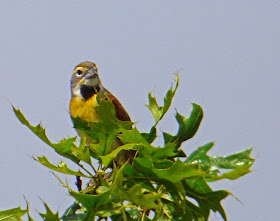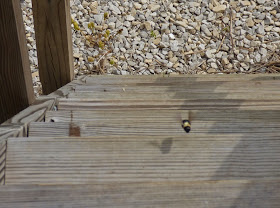 |
| Bobwhites at the Winery |
On the recommendation of a friend, we headed to Henderson, in Western Kentucky, to spend the night at
Ruby Moon Winery, which has a suite for overnight guests! We love going to local wineries, and Kentucky has an amazing number of them, but we've never been able to stay on the grounds before, so this was really a treat. After sampling some of their excellent wine, we did a little birding among the vines, and found the pair of Bobwhites we had heard from the room.
 |
| Dickcissel |
This morning, we boldly ignored the forecast of the Weather Channel for 90 - 100% chance of thunderstorms in the morning, and headed for the Sloughs WMA. (It never did rain.) Somehow we never get to join the Beckham Bird Club on its trip to this Wildlife Management Area, so we just decided to go on our own, and spent over 3 hours driving on quiet country roads where we could just stop if we saw or heard something interesting.
Several years ago, we drove to Missouri to visit Dick's only surviving aunt (now deceased), and she delighted in showing us all the places where the Dennis children of her generation had grown up. While there, I found a bird that resembled a Meadow Lark to me, but sounded completely different. It turned out to be a Dickcissel, and I hadn't seen one anywhere since then. Until today that is...
They called to each other for at least 8 miles up and down the road. This was just too cool!
So this is one bird song I'll always remember!
 |
| Red-winged Blackbird female |
|
 |
| Red-winged Blackbird male |
Of course, the Red-winged Blackbird was the most abundant, and certainly the noisiest bird we saw all day. The female is less showy, but just as attractive in her understated way as the male.
 |
| Indigo Bunting male |
We were not surprised to see no Eastern Bluebirds. The last two winters have just devastated their numbers. I hope they are nesting successfully somewhere. However, the Indigo Buntings were out in force today. They only look this dazzling blue when they are in the sunshine. Their feathers actually are not blue at all.
 |
| Indigo Bunting female |
Indigo Buntings solve the problem of cold winters by migrating away completely. I think this is the Bunting...or is it a female Blue Grosbeak? Not as likely, I'd say, since we didn't see any Blue Grosbeak males today. Her beak just looks a little large.
 |
| Solitary Sandpiper |
A "slough" (pronounced sloo, rhyming with too) is a swamp. This one comes and goes with the flooding of the nearby Ohio River. The slough fills the old riverbeds, and is maintained for hunters primarily. We were surprised not to find any hawks today, although a pair of Bald Eagles had a nest atop a dead tree far, far across the slough.
 |
| Carpenter Bee |
For an insect that can hover in the same spot for hours, it can be hard to get a photo of a carpenter bee that is focused right. Carpenter bees resemble bumblebees in both size and appearance, but are not social insects. They construct their nests in trees or in frame buildings. Most of the top of the abdomen of carpenter bees is without hairs and is shiny black in color. By contrast, the abdomen of bumblebees is fully clothed with hairs. The male bee is unable to sting, and it is the male carpenter bee which is most often noticed. They hover in the vicinity of the nest (i.e., any exposed piece of wood) and will dart after any other flying insect that ventures into their territory. A common behavior of the males is to approach people if they move quickly or wave a hand in the air. The males may even hover a short distance from people causing unnecessary panic. I know they aren't really dangerous, but their size and persistence makes them very intimidating. And boy, can they chase each other around!










Beautiful and captivating series.
ReplyDelete